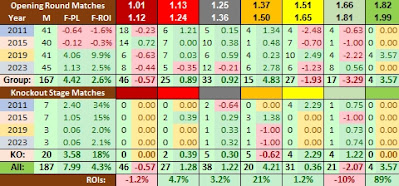Despite finishing with a loss in the final, my first real participation in cricket betting during this World Cup has been a positive one.
Tuesday, 21 November 2023
World Cup Cricket and Two-Thirds Century Wraps
Saturday, 18 November 2023
NBA Cup
Thursday, 16 November 2023
Gambler's Fallacy
I'm not going to mention any names, but one tipster with an excellent track record who I've been following for several years now, recently sent an update with an interesting, and surprising, suggestion:
We're currently a few points down for the season with both official and unofficial picks, so if you've been thinking about upping the stakes at some point, this should prove to be a great time to do that.I couldn't agree less. Increasing stakes in an effort to recoup prior losses is loss-chasing and something which is often viewed as a defining feature in the transition from recreational to problem gambling.
If your system is profitable at level stakes, there is never any need to chase your losses. The positive expected value (+EV) will, in the long run, result in profits.
Tuesday, 14 November 2023
Cricket and FRAN
Hi again, As I have often mentioned, I follow your blog with great admiration. What is your opinion on rating systems? On the one hand, ELO is often used to rate teams better. I use Ken Massey's site a lot. https://masseyratings.com/ Especially for college sports, it allows for very good ratings. Thank you very much and good luck.
While I love looking at ratings, the challenge I have is using them to beat the market. A little history, but back in 1987 (36 years ago!) I bought a book called The Punter's Revenge - Computers in the world of gambling - by Tony Drapkin and Richard Forsyth (I still have it in fact) and one chapter which had a big influence on me was 8.4 "Rating the strength of football teams".
The method was named FRAN (Football Rating Assessment Number) and was based on Elo (not ELO!) with Home teams "risking" 7% of their rating and Away teams 5%. I was quite fascinated by the idea, and spent many hours in the late 1980s / early 1990s maintaining ratings, looking for value, and with some success.
I remember one midweek round of matches when I had a number of multiple bets on Away wins in Divisions Three and Four, (in those days you couldn't bet on single matches), and all five landed for what, at the time, was a rather nice payout. I remember it because waiting for the final results to be confirmed made me late to meet a friend at the pub, and she was less than impressed with my excuse.
I think I've mentioned before that I'd look at the prices in the Racing Post on my commute into London, stop at a phone on my walk to the office and call in my bets which was great until my bookmaker accounts all got closed down in fairly quick succession, which was probably more than a coincidence, and made me realise that my time could probably be spent more profitably elsewhere. Similar to my reaction when told I'd have to pay Premium Charges, part of me was satisfied that the ban meant my success was being confirmed.
But I never forgot the idea, and many years later I resumed maintaining ratings on teams which is how I stumbled across the typical profile for matches with a higher than expected probability of ending up as a Draw, which became known as the XX Draws system back in 2012 or 2013.
Like everything else, the betting landscape has evolved a lot since the late 1980s. Betfair made it possible for me to make money consistently again from betting, but other, far more sophisticated organisations, were developing their own models to identify value, and a relatively basic model based on an Excel spreadsheet was never going to find an edge.
I think ratings compiled by others are a good starting point, but because they are widely available, you need to identify a weakness (one example might be the rating for home field advantage) and tweak the overall rating to improve it, but of course everyone else is trying to do the same thing.
Fortunately the sports markets aren't efficient, and in some cases remain inefficient for much longer than should be expected, and if you identify new trends early, and adapt your model accordingly, there is some hay to be made, at least for a while.
"The trend has vanished, killed by its own discovery." -Benoit B. Mandlebrot
Saturday, 4 November 2023
October: Texas, UMPO, Cricket, Indexes and Health
The 2023 baseball season came to an end earlier this week with yet another underdog win for the Texas Rangers who clinched their first ever World Series on the road in Arizona.
The three main problems people face when they retire are apparently "financial insecurity, health issues and social isolation" and October was at least a good month for the second of those categories.









